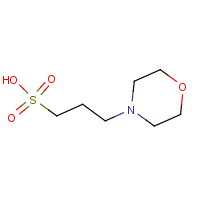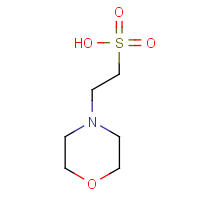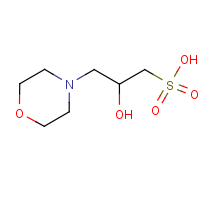The
zwitterionic buffer, also known as Good's Buffer, is a series of
N-substituted sulfamic acids that have good pH stability and are inert
to a variety of chemicals and enzymes. Among them, the morpholinic
buffers, including MOPS Sodium Salt,
MES, and MOPSO, have some common character, for example, they do not
form complexes with most metal ions and are therefore suitable for
solutions containing metal ions. But what is the difference between
them?
Let’see the following table:
Table 1. The comparation of MOPS, MES, MOPSO.
| Buffer | Structure | Full Name | Formula | pKa(25°C) | Buffering range |
| MOPS |  | 3-(N-morphine) Propanesulfonic acid | C7H15NO4S | 7.14 | 6.5~7.9 |
| MES |  | 2-(N-morpholino) ethanesulfonic acid | C6H13NO4S | 6.1 | 5.5~6.7 |
| MOPSO |  | 3-(N-morpholino)-2-hydroxypropanesulfonic acid | C7H15NO5S | 6.87 | 6.2~7.6 |
The application of MOPS, MES and MOPSO:
MOPS:
(1) running buffer in electrophoresis and protein purification in chromatography;
(2) Formulated into a variety of agar medium for the culture of bacteria, yeast and mammalian cells;
(3) Lysis buffer that can be used for Escherichia coli cells;
(4) as eluent in gel filtration chromatography;
(5) Northern blot as a buffer for RNA isolation and transfection;
(6) For bicinchoninic acid (BCA) assay;
(7) Studies on electron transport and phosphorylation of chloroplast sample preparation
(1) Biological buffer, can be used to replace highly toxic cacodylate, and ion buffer citrate and malate;
(2)
Buffered media commonly used for bacterial, yeast and mammalian cells.
High concentrations of MES are toxic to most plants, but can be used in
plant media at concentrations ~10 mM;
(3) as a buffer for studying Tau protein in culture;
(4)
Because of its low ion mobility and low conductivity at high
concentrations, it can be used in many types of electrophoresis and
chromatography including capillary electrochromatography, gel filtration
chromatography, phosphocellulose column chromatography, hydrophobic
interaction chromatography, cation exchange chromatography and SDS-PAGE;
(5) Complex with organotin (IV) molecules as antitumor agents.
(1) use as a carrier electrolyte in capillary electrophoresis, and as a crystallization buffer for glutathione synthetase;
(2) used in fluorescence spectrometry, spectrophotometry and isothermal titration calorimetry;
(3) Interaction with the peptide backbone of bovine serum albumin (BSA) to prevent thermal denaturation of BSA;
(4) as one of the buffer components for copper correlation analysis;
(5) used as a buffer carbon yeast extract medium composition;
(6) MOPSO-ethanol buffer system was prepared to fix urine-derived cells;
(7) A buffer system for the determination of biological by-products of marine crude oil.
Although
Good's buffer has the advantages of not participating in and not
interfering with the biochemical reaction process, not inhibiting the
enzymatic chemical reaction, and not reacting with the metal ion.
However, in the specific use, there are still some differences in the
application range of several morpholine series buffers MES, MOPS (CAS 1132-61-2)
and MOPSO. Therefore, it is necessary to consider the buffer
requirements and specific experimental types so as to select the most
appropriate buffer.
Edited by Suzhou Yacoo Science Co., Ltd.


